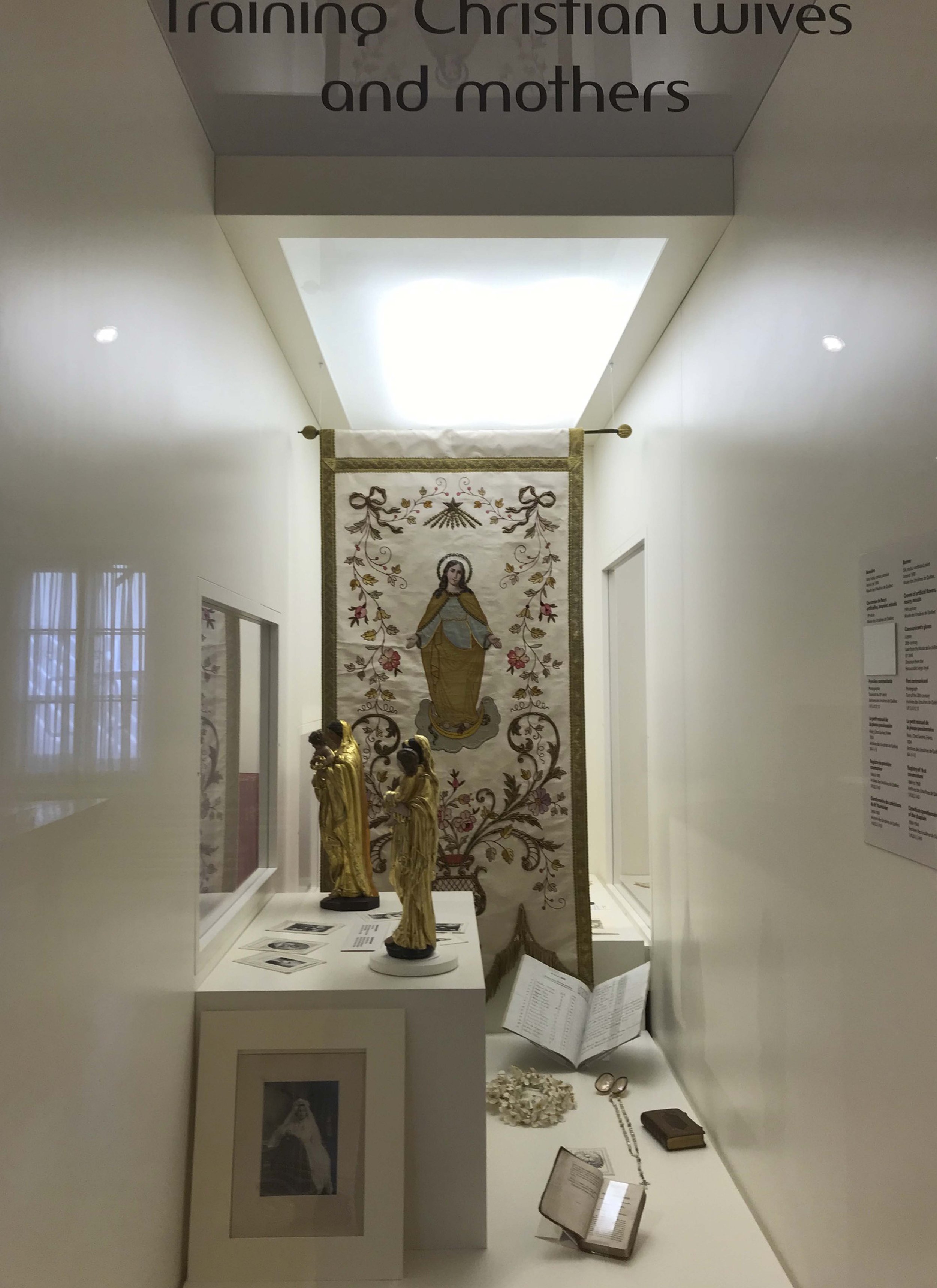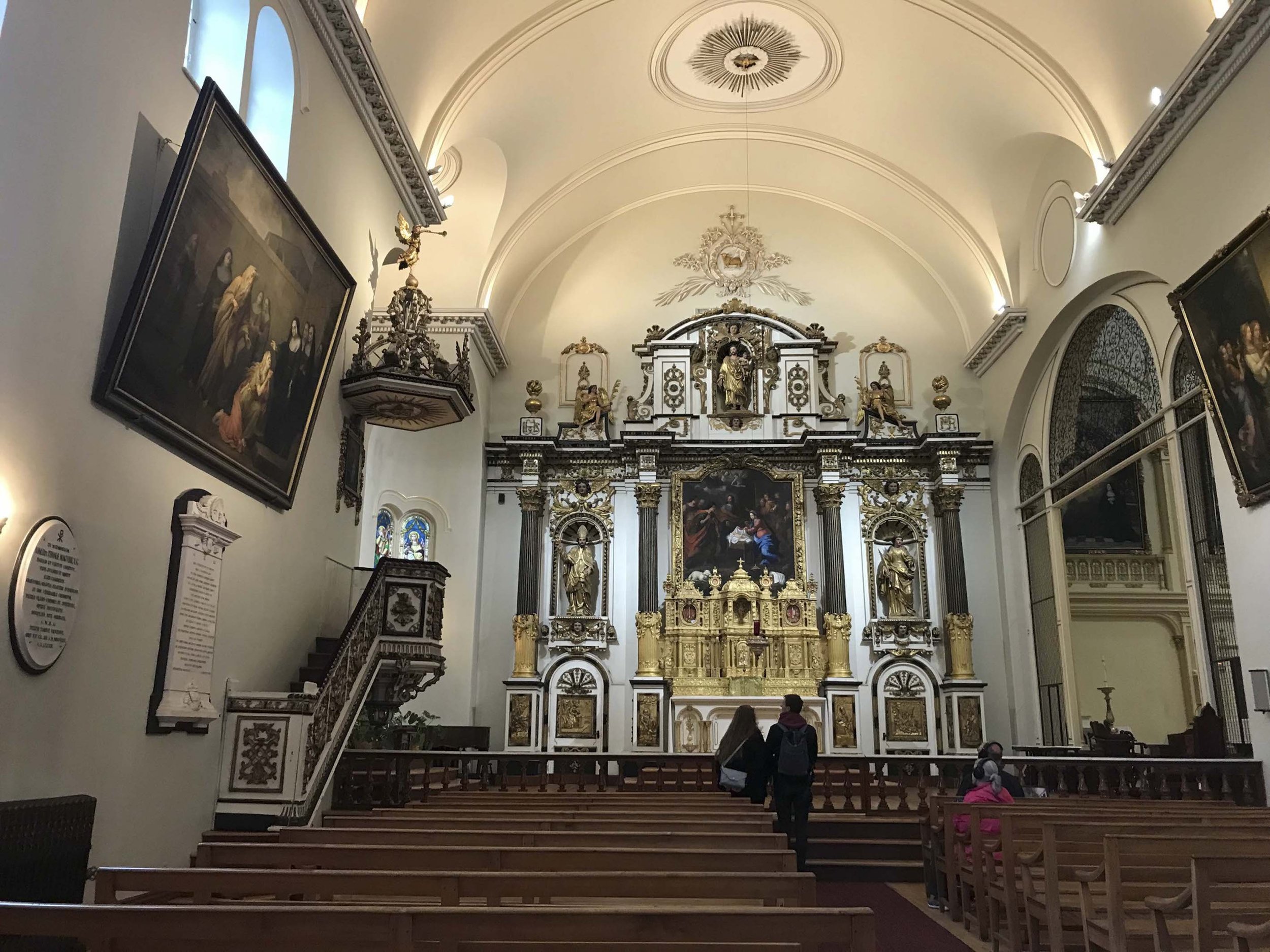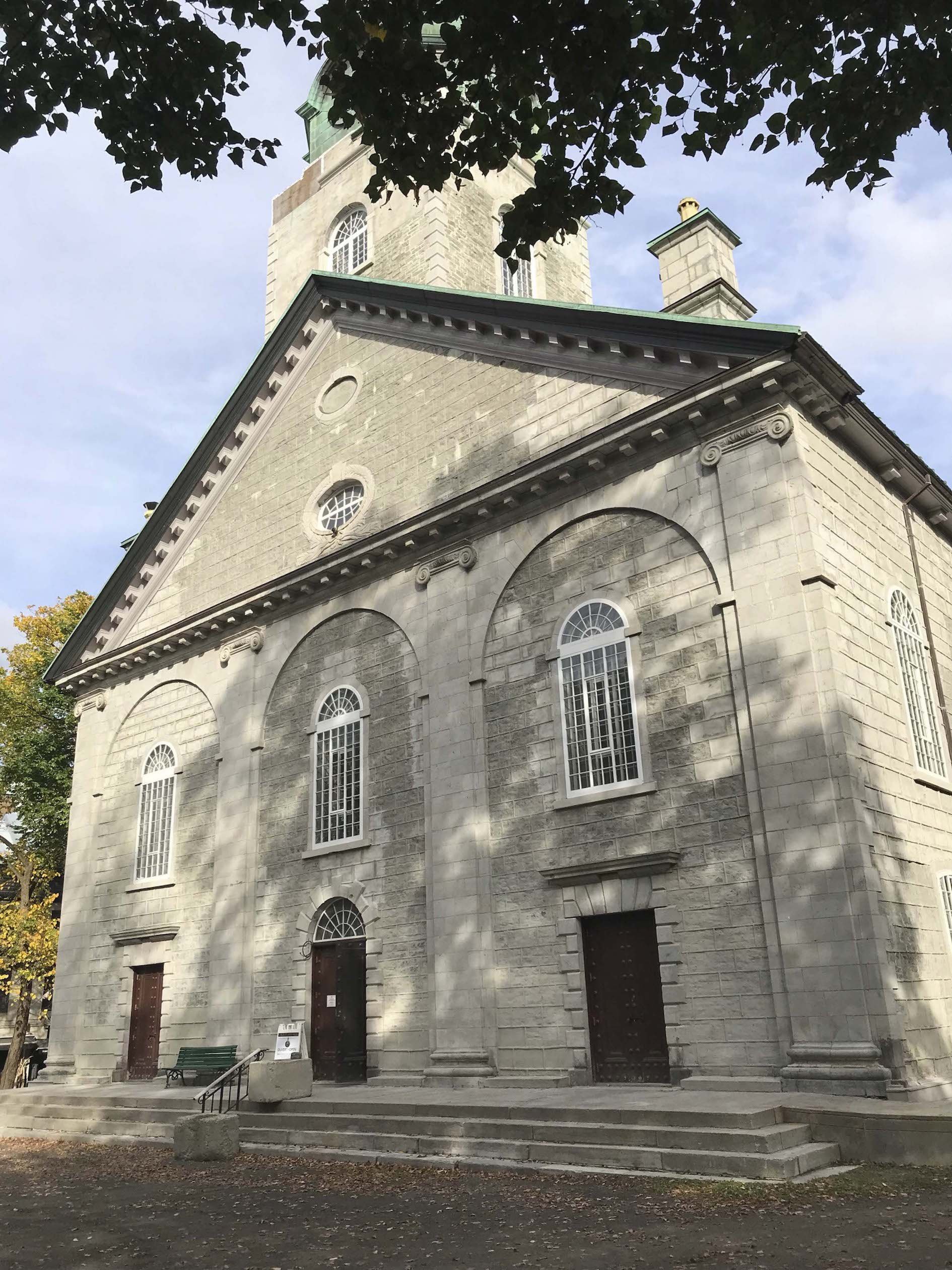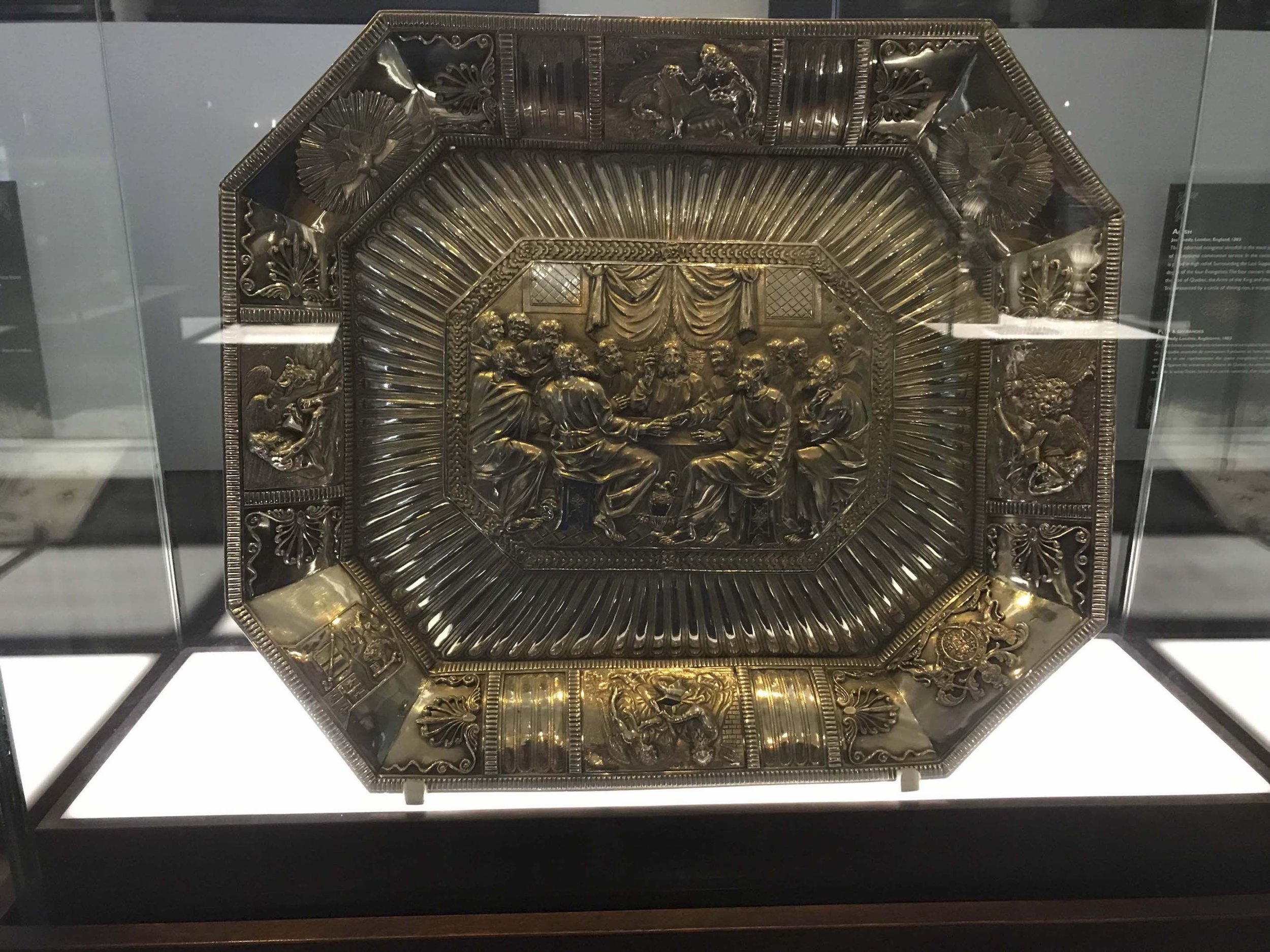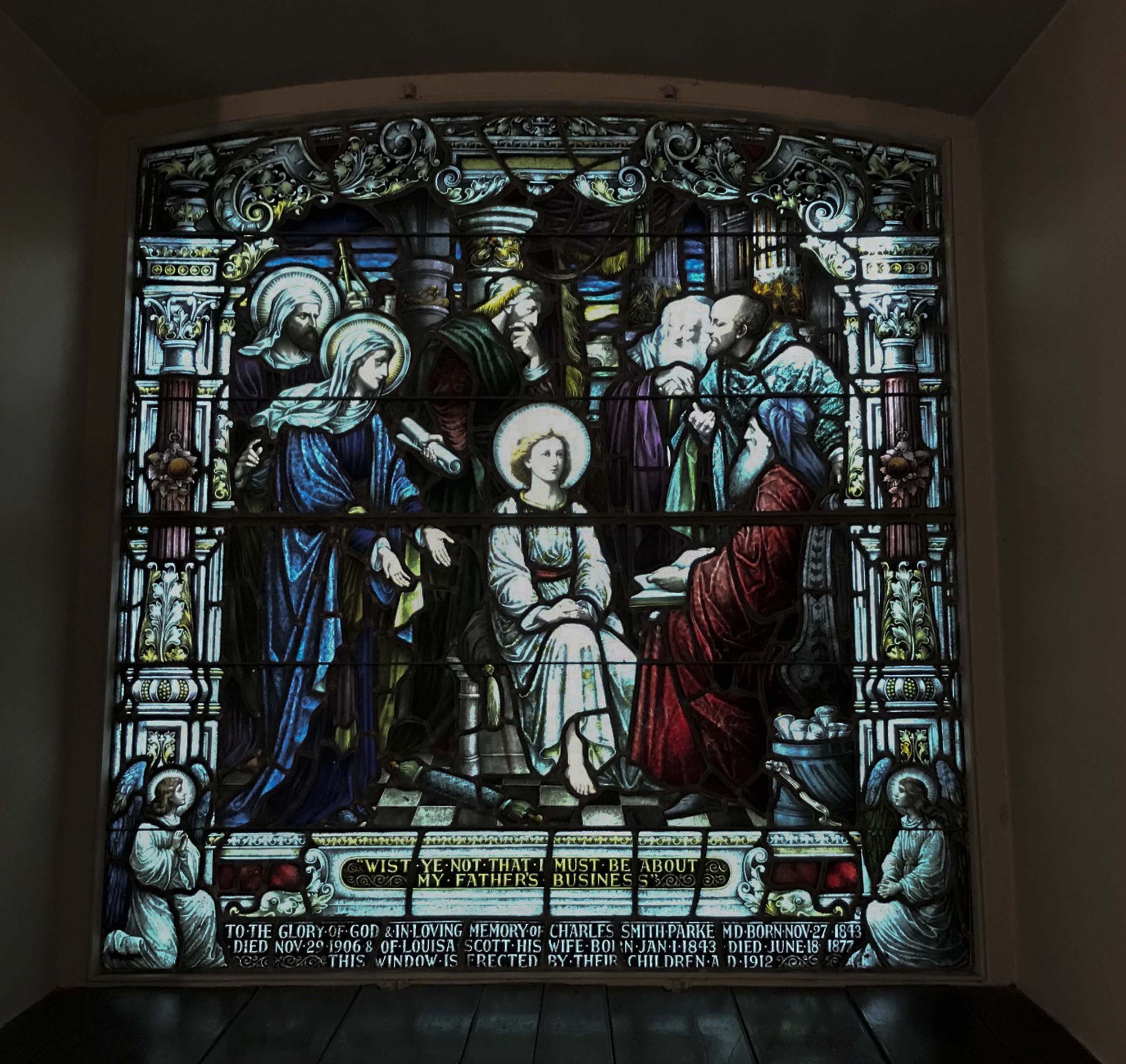The Monastery of the Ursulines and the Anglican Cathedral of the Holy Trinity, Québec City
By Charles D. Orzech
The modern city of Québec stands on the St. Lawrence river and is the capital of Québec province in Canada. From April to November it is a cruise ship destination, and its fancy shops and restaurants are thronged with tourists, in large part because its core—the old city—retains its walls and is touted as the only remaining European style city in North America. But beyond the steep streets and the vista over the St. Lawrence marked by the grand Frontenac Hotel, Québec City was shaped by the global conflict between France and England in the eighteenth and early nineteenth centuries. The history of this conflict is evident in its religious foundations. Within the embrace of the old walls are monasteries and religious foundations—Augustinians, Ursulines, Jesuits, Church of England, the Chalmers Wesley United Church, and the St. Andrews Church (Church of Scotland).
Church going in Québec Province has collapsed in the late twentieth century. Weekly attendance in Québec province is now by some accounts in the single digits, making Québec one of the most secular societies in the world [1]. The Augustinian Monastery is now a ‘heritage center’ and hotel [2]. In response, some of these institutions have foregrounded their treasuries and have rebranded themselves as museums and ‘cultural’ institutions. The Ursuline monastery is now the “Pôle cultural du Monastère des Ursulines.” Little more than an hour’s drive west Le Musée des Religions du Monde that had inherited the treasures of the now shuttered seminaries of Nicolet has recently been rebranded as “Le Musée des cultures du monde” [3]. In what follows I will describe two institutions that profoundly shaped the old city—the monastery and school of the Ursulines and the Cathedral of the Holy Trinity—the first Anglican cathedral built outside of Britain.
The Ursuline Monastery
The Ursuline order was founded by the sixteenth-century Italian Angela de Merici (1474-1540) in honour of the legendary St. Ursula [4]. A century later the Ursulines established themselves in New France (Nouvelle-France) under the leadership of Marie of the Incarnation (1599-1672). Arriving on the same ship as the Augustinian monks they were the first Catholic Nuns in what was in 1639 a small French colony in North America [5]. The core mission of the order was devoted to education, and early on they set about learning indigenous languages and educating indigenous girls. By the mid-1640s the order moved to a more permanent site in what is now the core of the old city of Québec. With various vicissitudes (fire, siege) they have been there since and have established daughter houses across what is now Canada and the United States. This is the oldest monastic complex in North America.
Figure 1. The Ursuline motherhouse in Québec. Wikimedia Commons, By Jeangagnon - Own work, CC BY-SA 3.0, https://commons.wikimedia.org/w/index.php?curid=23592003
One has to take time to find the Ursuline motherhouse in the old city of Québec. It nonetheless has some claim to be the heart of the French city. It occupies a sizable area in the western part of the old city and is accessed on rue Donnacona (Fig. 1). It is certainly off the beaten path, and when I have visited the street was quiet and the museum and church had no more than a handful of visitors. As of 2018 most of the sisters had relocated to assisted living [6]. Despite this shift, the school is still thriving with some 400 students in pre-primary and primary grades [7]. Nonetheless, a nearly four hundred year old religious institution in Québec City has transformed from a monastery and school to a museum and school.
The Museum
The entryway to the Musée des Ursulines is marked by a small sign in a courtyard opposite the entryway to the Ursuline chapel on rue Donnacona (Fig. 2). Erected in 1836 (with expansions in 1868) the museum building stands on the site of the secular foundress Madame de La Peltrie’s house (originally 1644) and served most of its life as a school. On entering one finds the reception desk and a small selection of books, to the left is entry to the museum. To the right is a small room currently displaying exquisite embroidered altar fronts (Fig. 3) and vestments as well as an area set up for people to try simple embroidery.
Figure 2. Entryway to the Ursuline chapel. Wikimedia Commons, By Jeangagnon - Own work, CC BY-SA 3.0, https://commons.wikimedia.org/w/index.php?curid=28387471
Figure 3. Embroidery. Photograph by author.
The museum occupies three floors, and its exhibits trace the history and methods of the educational mission of the Ursulines over nearly four hundred years. While the Ursulines have many treasures (see “Collections” tab on the website), the museum primarily displays objects related to the educational mission of the sisters [8].
Figure 4: “Training Christian Wives & Mothers.” Photograph by author.
There are two permanent exhibits, “The Young Ladies Academy” and “Recollections of a House”, the former focused on education and the lives of young female day students and postulants occupying most of the two upper floors, the latter on the first floor being a treatment of the evolution of the house. “The Young Ladies Academy” tells an impressive story through mostly mundane objects [9]. While early efforts of the sisters included education of the local Algonquin speaking peoples, the education provided to young girls in the sciences, languages, and the arts—particularly during the nineteenth and twentieth centuries—was remarkably progressive [10]. Everyday outside play-time was mandatory, and corporal punishment was not allowed. The “Training of Christian Wives and Mothers” was a matter of course (Fig. 4). However, topics that were not widely regarded as suitable for females were given as much, if not more, emphasis. There are games for learning botany (Fig. 5), scientific instruments including microscopes, devices for helping to understand the movements of the planets and moons (Fig. 6), instruction in logical reasoning (Fig. 7), instruction in European languages (German, English, French; though Greek and Latin were reserved for the boys being educated elsewhere in the city by the Jesuits), drawing and painting (Fig. 8), music, hairwork (Fig. 9), and of course embroidery. Current temporary exhibits include “Embroider like an Ursuline” and “We Grow up by Playing” [11].
Figure 5. Game for learning the names of flowers. Photograph by author.
Figure 6. Apparatus for learning about celestial movements. Photograph by author.
Figure 7. Instruction in Logic. Photograph by author.
Figure 8. Instruction in Drawing and Painting. Photograph by author.
Figure 9. Hair-work. Photograph by author.
The Chapel
Entry to the Chapel is opposite the Ursuline Museum. The building is ‘L’ shaped with the monastic axis oriented in the traditional northwest to southeast direction, placing the altar at the East end. The ‘public’ portion of the chapel is oriented northeast to southwest. The altar stands at the intersection of the two legs where in a traditional church one would find the crossing. Thus, the cloistered nuns could worship facing the altar separated by the grill and out of sight from lay Catholics in the nave of the public portion of the chapel.
Figure 10. Oratory. Photograph by author.
The Oratory (Fig. 10) dedicated to the foundress Saint Marie of the Incarnation is adjacent to the east. Accessible to the public it offers views of the monastic side of the chapel through grillwork (Fig. 11). Visitors often inscribe prayers on slips of paper and place them in a bowl near the saint’s tomb.
Figure 11. Convent side of the Chapel. Photograph by author.
Although the chapel was rebuilt in 1902, it houses exquisite examples of woodcarving dating from the first half of the eighteenth century which were moved from the earlier chapel. Gilded by the Ursulines, these encompass the main altar (1736, faced by lay worshippers, Fig. 12), the pulpit (1726), and the Sacred Heart altar (faced by the nuns, 1729), all from the workshop of Pierre-Noël Levasseur [12]. The chapel contains numerous memorials and hatchments and notably one to Louis-Joseph de Montcalm, commander of the French forces, who died of his wounds at the Battle of the Plains of Abraham just to the west of the city walls (1759) that sealed British victory over the French in North America. He was originally buried under the choir of the Ursuline church [13].
Figure 12. Chapel Main (public) altar. Photograph by author.
Of particular note in the Chapel are some fifteen paintings that form a part of the Desjardins Collection (others are held in the Musée national des beaux-arts du Québec) [14]. The collection preserves masterpieces of seventeenth- and eighteenth-century French painting that were shipped to New France to avoid their destruction during the revolution. The paintings in the chapel constitute a small part of some 300 paintings held by the monastery, some of them painted by the sisters. The huge canvas “Jesus in the Home of Simon the Pharisee” by Philippe de Champaigne (1602-1674) was confiscated in Paris and cut into two, and eventually the two halves were reunited. It hangs over the chapel entryway (Fig. 13). Hanging over the main altar is “The Nativity: Adoration of the Shepherds” attributed to Lebrun (1619-1690). Another painting toward the rear of the chapel portrays the “Holy Family with the infant Jesus blessing a Huron girl”. It is attributed to Frère Luc (1614-1685) and can be seen in the lower left of “Jesus in the Home of Simon the Pharisee” (it is also visible in the 3D tour of the monastery mentioned below).
Figure 13. Jesus in the Home of Simon the Pharisee. Photograph by author.
The Website
The website of the Ursuline Monastery offers an excellent overview of the foundation and its evolution [15]. Also available are links for researchers, video tours of the chapel, educational programs, and in-person tours. What stands out, however, is a 3D virtual tour of the complex, most of which is still closed to visitors [16].
Cathedral of the Holy Trinity Québec City
Figure 14. Cathedral of the Holy Trinity Exterior.Photograph by author.
A few minutes’ walk east of the Ursuline monastery brings a visitor into what is today the heart of the tourist district just to the north of the Hotel Fontenac. The Anglican Cathedral of the Holy Trinity—the first such cathedral outside of the British Isles—was commissioned in 1800 and completed in 1804 [17] (Fig. 14). Forty years on from General Wolfe’s victory over Montcalm on the Plains of Abraham just to the west of the city walls, it marks British control over the formerly French territory. Roughly oriented with its altar to the east, the building was modelled on St. Martin-in-the-Fields in London, though with some notable compromises. The columned portico of St. Martin’s is replaced by a flattened stone front, and shortly after the initial construction the angle of the roof had to be increased to withstand the weight of snow [18]. Entering through the west door one encounters the baptismal font and a view of the grand east window depicting Christ risen (Fig. 15). The placement of the font is indicative of changes introduced during the nineteenth century, such as the use of stained glass in place of the original clear glass. The changes track the growing influence of Anglican ‘high church’ movements that saw Anglican churches move back toward a more sacramental arrangement of church spaces [19]. Among its many treasures one stands out. A glass-walled enclosure in the north aisle displays an elaborate ten piece silver communion service given by King George III—an imperial and ecclesiastical imprimatur of Britain’s dominance in North America [20] (Figs 16 & 17). The service, including a paten carrying both the royal and bishop’s arms Fig. 18), underscores the role of George as both king and head of the Church [21]. For many years the cathedral was the tallest building in the city (Fig. 19 view of cathedral from Ursulines) and it contains a pew reserved for the King. In contrast to the Ursuline chapel, the Cathedral of the Holy Trinity still holds services.
Figure 15. Cathedral of the Holy Trinity Interior. Photograph by author.
Figure 16. King’s Gift 1. Photograph by author.
Figure 17. King’s Gift 2. Photograph by author.
Figure 18. King’s Gift. Wikimedia Commons By Fred C. Würtele. This file has been provided by the British Library from its digital collections. It is also made available on a British Library website. Catalogue entry: HS85/10/13408, Public Domain, https://commons.wikimedia.org/w/index.php?curid=26881757
Figure 19: View of the Cathedral from the Ursulines By James Pattison Cockburn (1779-1847) - collections.rom.on.ca, Public Domain, https://commons.wikimedia.org/w/index.php?curid=75005599
The nineteenth-century ecclesiological influences set the stage for other notable treasures in the Cathedral, including its superb windows and its change-ringing bells. The stained glass memorial windows date from the 1860s onward and are primarily the products of two London firms (Clutterbuck, Clayton and Bell) and a Montreal firm (John C. Spence & Sons) founded by an English artist [22] (Fig. 20). The East window depicting Christ risen is a particularly striking example and others are available for examination on the Cathedral website [23]. The Cathedral’s eight bells were cast in 1830 at the Thomas Mears II foundry in London. In 2006 they were returned to the Whitechapel Bell Foundry in London for refurbishment and tuning [24]. Change ringing Bells are rare in Canada, and a team of eight ringers is required for their use. The main organ of the Cathedral dates from 1884-85 and was built by Charles Sumner Warren [25]. There are also many memorials including one to the Duke of Richmond who served as Governor-in-chief of British North America. The Duke and Duchess famously hosted a ball on the eve of the battle of Waterloo. Byron wrote of the event, as did Thackeray [26]. The memorials, the windows, the silver, and most other aspects of the Cathedral are now visually accessible through a superb interactive virtual program. As a supplement to an in-person visit this site makes it possible to see parts of the Cathedral that are too high or otherwise difficult to get close to [27].
Figure 20. Stained Glass. Photograph by author.
Perhaps because of its role as a Cathedral, Holy Trinity continues to hold services despite dwindling church attendance. While there are still active Ursuline and other Catholic foundations in Québec and elsewhere in Canada, the move toward rebranding as heritage or cultural patrimony is evident in Québec city. The Ursulines, continuing their educational mission, have at least for now resisted total museumification.
Notes
[1] Depending on the source, weekly attendance of Catholic Mass is running between 2 and 11 percent. See Dean Detloff, “Catholics in Quebec are leaving the church in droves. Can reinventing parish life save it?” America: the Jesuit Review, February 25, 2021. https://www.americamagazine.org/politics-society/2021/02/25/catholic-church-quebec-reinventing-parish-life-240097 .
[2] https://www.quebec-cite.com/en/businesses/le-monastere-des-augustines. For the Augustinian monastery in Québec see Jean Simard, “The Augustinian Monastery of Quebec,” in The Encyclopedia of French Cultural Heritage in North America, http://www.ameriquefrancaise.org/en/article-570/The_Augustinian_Monastery_of_Quebec.html.
[3] https://www.museedescultures.com/musee/. For a discussion of this museum prior to its rebranding see Charles D. Orzech, Museums of World Religions: Displaying the Divine, Shaping Culture, (London: Bloomsbury Academic, 2020), 96-110.
[4] For Saint Ursula see, George C. Herbermann, et al., The Catholic Encyclopedia: an International Work of Reference On the Constitution, Doctrine, Discipline, And History of the Catholic Church, (New York: Robert Appleton Co., 1907-1912) vol. 15 pp. 225-228. Hathi Trust https://babel.hathitrust.org/cgi/pt?id=umn.31951002037604c&seq=257. Also available at Internet Archive: https://archive.org/details/catholic-encyclopedia-volum-15/page/225/mode/2up.
[5] The Catholic Encyclopedia has a concise essay on the founding of the Ursuline order and its work in Québec on pages 228-230. Hathi Trust https://babel.hathitrust.org/cgi/pt?id=umn.31951002037604c&seq=261. Also at Internet Archive: https://archive.org/details/catholic-encyclopedia-volum-15/page/229/mode/2up.
[6] See the report by Philippe Vaillancourt, “End of an era: Quebec Ursulines leave seventeenth-century monastery, Crux, September 29, 2018. https://cruxnow.com/church-in-the-americas/2018/09/end-of-an-era-quebec-ursulines-leave-17th-century-monastery.
[7] The school website is at https://euq.ca.
[8] The website of the museum is at https://www.polecultureldesursulines.ca/en/. For the Collections see https://www.polecultureldesursulines.ca/en/collections-pole-culturel-du-monastere-des-ursulines/.
[9] https://www.polecultureldesursulines.ca/en/exhibition-young-ladies-academy/.
[10] On early educational practices of the Ursulines particularly with reference to the education of indigenous children see Mairi Cowan, “Education, Francisation, and Shifting Colonial Priorities at the Ursuline Convent in Seventeenth-Century Québec,” Canadian Historical Review, 99.1 (2018), 1-29.
[11] On Ursuline embroidery see https://www.polecultureldesursulines.ca/en/exhibition-embroider-like-ursuline/ . For “We grow up by Playing” see https://www.polecultureldesursulines.ca/en/exhibition-we-grow-up-by-playing/.
[12] See “The Ursuline Chapel” https://www.polecultureldesursulines.ca/en/chapel/ as well as the discussion at the Religious Heritage / Patrimoine religieux website: https://epe.lac-bac.gc.ca/100/205/301/ic/cdc/relig/ursul/ursuline.htm.
[13] For a discussion of the battle Wikipedia is useful as a starting place (https://en.wikipedia.org/wiki/Battle_of_the_Plains_of_Abraham). The “History and Heritage” tab of the Canadian Government website is also useful for an overview (https://www.ccbn-nbc.gc.ca/en/).
[14] For a brief introduction see the website concerning the collection and its exhibit at the Musée national des beaux-arts du Québec: https://www.mnbaq.org/en/exhibition/the-fabulous-destiny-of-the-paintings-of-the-abbes-desjardins-1247.
[15] https://www.polecultureldesursulines.ca/en/.
[16] The 3D virtual tour is available at https://www.monastere3d.com/index.php.
[17] David Mendel provides a brief but informative guide, Cathedral of the Holy Trinity, Éditions Sylvan Harvey, 2015. For the Website see https://www.cathedral.ca/visites/#Decouvrir.
[18] For the history of the building and its adaptation to local circumstances see the Cathedral website “History” tab https://www.cathedral.ca/the-cathedral/#Histoire.
[19] On ‘high church,’ ecclesiological, or Oxford Movement and its impact on church architecture, decoration, and ritual see especially Stewart J. Brown, Peter B. Nockles, and James Pereiro (eds), The Oxford Handbook of the Oxford Movement (2017; online edn, Oxford Academic, 6 July 2017), https://doi.org/10.1093/oxfordhb/9780199580187.001.0001
[20] George III commissioned the royal goldsmiths firm Rundell and Bridge to produce the silver service for the new Cathedral. A brief discussion with images is “The King’s Gift” on the Cathedral website https://www.cathedral.ca/the-kings-gift/.
[21] Mendel has a more detailed treatment pp. 42-47.
[22] Mendel pp. 29-33.
[23] Several You Tube videos can be accessed through the Cathedral site: https://www.cathedral.ca/windowsrelexions/.
[24] Mendel, 53-55 for the renovation, tuning, and rehanging. Many other famous bells were produced from this foundry. The foundry was in business from 1570 until 2017 and produced, among many others, the Liberty Bell and the bells of Big Ben. Wikipedia has an excellent discussion, https://en.wikipedia.org/wiki/Whitechapel_Bell_Foundry, and there is an index of carillons and chimes produced by the foundry at http://www.towerbells.org/data/IXfoundryWhitechapel.html.
[25] Mendel, 48-51.
[26] Byron’s “the Eve of Waterloo” describing the Ball is part of the much longer Childe Harold’s Pilgrimage. For the poem see https://allpoetry.com/The-Eve-Of-Waterloo.
[27] The tour is available in French, English, and Spanish at https://www.cathedral.ca/virtual-visit/.
Charles D. Orzech is Professor Emeritus of Religious Studies at the University of North Carolina Greensboro, and Professor Emeritus of Religious Studies and formerly chair of the Art Department at Colby College. He has also been Reader in Religion, Conflict and Transition in the School of Critical Studies at the University of Glasgow. He holds a Ph.D. in Divinity (History of Religions) from the University of Chicago. His research has focused on the translation and transformation of Indian Mahāyāna Buddhism in eighth-through thirteenth-century China. Author of Politics and Transcendent Wisdom: The Scripture for Humane Kings in the Creation of Chinese Buddhism (Pennsylvania State University Press, Hermeneutics Series, 1998), Orzech was General Editor and China area editor of Esoteric Buddhism and the Tantras in East Asia (E. J. Brill, 2011). He also studies religious objects and their presentation in museums. His Museums of World Religions: Displaying the Divine, Shaping Culture was published in Bloomsbury’s Studies in Material Religion series in 2020.



